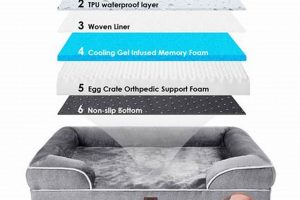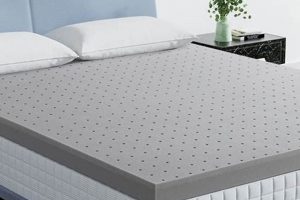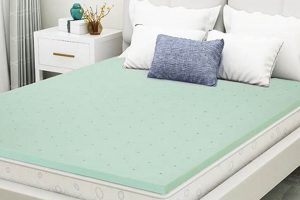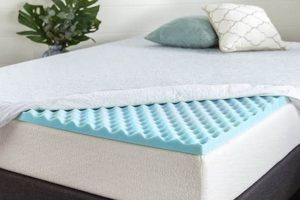A large-size bed accessory designed to enhance comfort, this product is constructed from viscoelastic foam. It is intended to be placed atop an existing innerspring, latex, or foam mattress to modify its feel. Its purpose is to contour to the body, providing pressure relief and improved spinal alignment. For instance, an individual might purchase this product to soften a too-firm sleeping surface.
This type of bed enhancement offers multiple advantages, including improved sleep quality, reduced motion transfer, and increased mattress longevity. The viscoelastic material adapts to the sleeper’s form, distributing weight evenly and minimizing pressure points. Historically, the incorporation of this material into bedding represented a significant advancement, offering a more personalized and supportive sleep experience.
The following sections will delve into the specific features, benefits, purchasing considerations, and maintenance tips related to this type of sleep surface enhancement. This will enable informed decision-making regarding this product category.
Tips for Selecting a King Mattress Topper
The selection of a viscoelastic foam enhancement for a king-size bed requires careful consideration. The following tips will assist in navigating the available options and ensuring optimal satisfaction.
Tip 1: Density Assessment. A higher density indicates greater support and durability. Examine product specifications to ascertain the foam’s density, typically measured in pounds per cubic foot (lbs/ft). A density of 4 lbs/ft or higher is generally recommended for enhanced longevity.
Tip 2: Thickness Considerations. The appropriate thickness depends on the desired level of modification to the existing mattress. Thicker toppers, ranging from 3 to 4 inches, provide more significant contouring and pressure relief, while thinner options offer a subtle enhancement.
Tip 3: Understanding Indentation Load Deflection (ILD). ILD measures the firmness or softness of the foam. A lower ILD signifies a softer feel. Evaluate personal comfort preferences when considering this metric.
Tip 4: Temperature Regulation. Viscoelastic foam can retain heat. Consider options with cooling technologies, such as gel infusions or open-cell structures, to mitigate potential heat buildup and promote airflow.
Tip 5: Certifications and Standards. Look for certifications such as CertiPUR-US, which verifies that the foam has been tested for harmful substances and meets standards for emissions, content, and durability.
Tip 6: Return Policies and Warranties. Ensure that the product is backed by a reasonable return policy and warranty. This allows for assessment of the topper’s suitability and recourse in the event of manufacturing defects.
Careful application of these guidelines can significantly improve the likelihood of selecting a suitable and satisfying enhancement for a king-size bed.
The subsequent sections will address the practical aspects of maintenance and care, further extending the lifespan and optimizing the performance of this bedding component.
1. Density
Density is a pivotal characteristic dictating the performance and longevity of a viscoelastic foam enhancement designed for a king-size bed. It directly influences the level of support, durability, and overall comfort experienced by the user. Understanding density is paramount when selecting an appropriate product.
- Support and Pressure Relief
Higher density foams offer greater resistance to compression, providing more consistent support across the surface. This enhanced support translates to improved spinal alignment and reduced pressure points, particularly beneficial for individuals with back pain or other musculoskeletal issues. For example, a high-density topper can prevent excessive sinking, maintaining a more neutral spine position.
- Durability and Lifespan
Density correlates directly with the lifespan of a viscoelastic foam enhancement. High-density foams are less prone to sagging and deformation over time, maintaining their supportive qualities for a longer duration. A low-density topper, conversely, may degrade rapidly, requiring more frequent replacement. A topper with a density of 5 lbs/ft will typically outlast one with a density of 3 lbs/ft.
- Motion Isolation
Denser foams are more effective at isolating motion. This is particularly advantageous for couples sharing a king-size bed, as it minimizes the transfer of movement from one sleeper to the other. The denser material absorbs and dampens motion, reducing disturbances and promoting uninterrupted sleep. For example, one partner tossing and turning is less likely to affect the other when using a high-density topper.
- Cost and Perceived Value
Density generally influences the price of a viscoelastic foam enhancement. Higher density foams typically command a premium due to the increased material cost and enhanced performance characteristics. However, the extended lifespan and improved comfort often justify the higher initial investment. A less expensive, low-density topper may require more frequent replacement, ultimately costing more in the long run.
In summary, density is a critical attribute to consider when selecting a viscoelastic foam enhancement for a king-size bed. It directly impacts support, durability, motion isolation, and overall value. Careful evaluation of density ensures a comfortable and supportive sleeping surface, ultimately contributing to improved sleep quality and long-term satisfaction.
2. Thickness
Thickness, in the context of a king-size viscoelastic foam enhancement, is a critical parameter determining the extent to which the product modifies the characteristics of the underlying mattress. It dictates the level of contouring, pressure relief, and overall comfort experienced by the sleeper, influencing the suitability of the topper for individual needs.
- Impact on Pressure Relief
A thicker viscoelastic foam enhancement provides a greater degree of conformity to the body’s contours. This enhanced conformity results in a more even distribution of weight, reducing pressure points at areas such as the shoulders, hips, and knees. For example, a 4-inch topper will typically offer more significant pressure relief than a 2-inch topper, particularly for side sleepers.
- Influence on Mattress Firmness
The thickness of the topper directly affects the perceived firmness of the underlying mattress. A thicker topper can effectively soften a too-firm mattress, creating a more comfortable sleeping surface. Conversely, a thinner topper may offer only a subtle change in firmness. An individual seeking to significantly soften a firm mattress might opt for a 3- or
4-inch viscoelastic foam enhancement. - Effect on Spinal Alignment
Appropriate thickness contributes to proper spinal alignment during sleep. By conforming to the body’s natural curves, a viscoelastic foam enhancement can help maintain a neutral spinal position, reducing strain on the back and neck. A topper that is too thin may not provide sufficient support, while one that is too thick may cause excessive sinking. The optimal thickness depends on body weight, sleeping position, and individual preferences.
- Relationship to Heat Retention
Thicker viscoelastic foam enhancements tend to retain more heat than thinner options. This is due to the increased volume of material, which limits airflow and traps body heat. Individuals prone to overheating may consider thinner toppers or those incorporating cooling technologies, such as gel infusions or open-cell structures. A thinner topper may promote better ventilation and reduce the risk of night sweats.
The thickness of a king-size viscoelastic foam enhancement directly impacts its performance characteristics, including pressure relief, firmness modification, spinal alignment support, and heat retention. Selecting the appropriate thickness is essential for achieving optimal comfort and sleep quality. Careful consideration of these factors ensures that the enhancement effectively addresses individual needs and preferences, maximizing the benefits of this bedding component.
3. Firmness
Firmness, within the context of a king-size viscoelastic foam enhancement, denotes the degree of resistance the material offers to compression. It serves as a primary determinant of the sleeper’s experience, impacting comfort, support, and spinal alignment. Variations in firmness cater to diverse physiological needs and preferences. For instance, a side sleeper might benefit from a softer topper to allow for shoulder and hip cushioning, while a back sleeper may prefer a firmer surface to maintain spinal alignment. The selection of an inappropriate firmness level can lead to discomfort or exacerbate existing musculoskeletal issues.
The firmness of a viscoelastic foam enhancement is often quantified using Indentation Load Deflection (ILD), a measurement of the force required to compress the material a specific percentage. A lower ILD value indicates a softer feel, whereas a higher value signifies greater firmness. Manufacturers typically provide ILD ratings to assist consumers in making informed decisions. The practical significance of understanding firmness lies in its direct correlation with the quality of sleep and overall well-being. A correctly chosen firmness level can alleviate pressure points, reduce tossing and turning, and promote a more restful and restorative sleep cycle. Conversely, an unsuitable firmness can lead to discomfort, disrupted sleep, and potential long-term health consequences.
In conclusion, firmness represents a fundamental characteristic of viscoelastic foam enhancements for king-size beds, influencing comfort, support, and spinal alignment. Understanding ILD ratings and aligning firmness with individual sleeping habits and physiological needs is crucial for selecting an appropriate product. Challenges remain in accurately conveying the subjective experience of firmness through standardized measurements, highlighting the importance of considering customer reviews and return policies. A thorough understanding of this characteristic is essential for maximizing the benefits and minimizing the potential drawbacks of using a viscoelastic foam enhancement.
4. Cooling
Temperature regulation is a significant concern regarding viscoelastic foam enhancements for king-size beds. The inherent properties of viscoelastic foam can lead to heat retention, potentially causing discomfort and disrupting sleep. Addressing this issue through various cooling technologies and design modifications is critical for enhancing the overall user experience.
- Gel Infusions
The incorporation of gel particles within the viscoelastic foam matrix is a common cooling strategy. These gels, often phase-change materials, absorb and dissipate heat, creating a cooler sleeping surface. For example, a topper infused with gel beads may maintain a lower temperature compared to a standard viscoelastic foam topper, particularly during extended periods of use. This reduces the incidence of night sweats and improves sleep quality.
- Open-Cell Structure
Traditional viscoelastic foam features a closed-cell structure, restricting airflow and trapping heat. Open-cell viscoelastic foam, on the other hand, allows for greater air circulation, facilitating heat dissipation. This design modification promotes a more breathable sleeping environment, reducing heat buildup. The open-cell structure minimizes the insulating effect of the foam, contributing to a cooler feel.
- Ventilated Designs
Some king-size viscoelastic foam enhancements incorporate physical ventilation channels or perforations to further enhance airflow. These designs create pathways for heat to escape, promoting convective cooling. For instance, a topper with strategically placed ventilation holes can dissipate heat more effectively than a solid foam block. This minimizes heat retention and contributes to a more comfortable sleeping temperature.
- Material Combinations
Manufacturers often combine viscoelastic foam with other materials known for their cooling properties, such as bamboo or Tencel fabrics. These materials are used in the topper’s cover to wick away moisture and promote evaporation, further enhancing cooling. The combination of a breathable cover with cooling-enhanced foam creates a multi-layered approach to temperature regulation.
The application of these cooling technologies significantly mitigates the heat retention associated with viscoelastic foam. By incorporating gel infusions, open-cell structures, ventilated designs, and complementary materials, manufacturers are improving the comfort and suitability of king-size viscoelastic foam enhancements for a wider range of sleepers. The effectiveness of these cooling features depends on individual factors, such as body temperature and ambient room conditions, but they represent a significant advancement in addressing a common concern associated with this type of bedding.
5. Certifications
Certifications, in the context of king-size viscoelastic foam enhancements, provide independent verification that a product meets specific safety, environmental, or performance standards. These certifications are crucial for consumer confidence and informed purchasing decisions, addressing concerns about material composition and manufacturing processes.
- CertiPUR-US Certification
This certification indicates that the viscoelastic foam has been tested by an independent laboratory and meets specific criteria for content, emissions, and durability. Certified foams are made without ozone depleters, PBDEs, TDCPP or TCEP (“Tris”) flame retardants, mercury, lead, and other heavy metals. They also have low VOC (Volatile Organic Compound) emissions for indoor air quality (less than 0.5
parts per million). For a king-size viscoelastic foam enhancement, this certification assures consumers that the product minimizes potential exposure to harmful chemicals. - OEKO-TEX Standard 100 Certification
This certification focuses on the textiles used in the cover of the king-size viscoelastic foam enhancement. It verifies that every component of the product, from the fabric to the thread and zipper, has been tested for harmful substances and is harmless for human health. This is particularly relevant for individuals with sensitivities or allergies, as it minimizes the risk of skin irritation or allergic reactions.
- GREENGUARD Certification
GREENGUARD Certification ensures that the product has met some of the world’s most rigorous and comprehensive standards for low emissions of volatile organic compounds (VOCs) into indoor air. This is critical for maintaining healthy indoor air quality, especially in bedrooms where individuals spend a significant portion of their time. A king-size viscoelastic foam enhancement bearing this certification has undergone testing to minimize potential VOC off-gassing.
- Third-Party Testing and Verification
Beyond specific certifications, the presence of general third-party testing and verification further reinforces product quality and safety. Independent laboratories assess various performance characteristics, such as durability, support, and heat retention. This provides consumers with unbiased data to compare different king-size viscoelastic foam enhancements and make informed choices based on verified product attributes.
These certifications collectively offer a framework for evaluating the safety and quality of king-size viscoelastic foam enhancements. By prioritizing products with recognized certifications, consumers can mitigate potential risks associated with material composition, emissions, and manufacturing processes, ensuring a healthier and more comfortable sleep environment. The presence of these certifications represents a commitment from manufacturers to transparency and responsible production practices.
6. Warranty
The warranty accompanying a king-size viscoelastic foam enhancement is a significant factor in the purchasing decision. It represents a manufacturer’s assurance regarding product durability and performance, providing recourse in the event of defects or premature degradation. Understanding the scope and terms of the warranty is essential for protecting the investment.
- Coverage Period
The duration of the warranty dictates the period during which the manufacturer is responsible for addressing covered issues. A longer warranty suggests greater confidence in the product’s longevity. For example, a five-year warranty on a king-size viscoelastic foam enhancement provides extended protection compared to a one-year warranty. The specific issues covered, such as sagging or loss of shape, are delineated within the warranty document.
- Defects Covered
Warranties typically cover manufacturing defects in materials or workmanship. This may include issues such as uneven foam density, premature deterioration, or separation of layers. For instance, if a king-size viscoelastic foam enhancement develops significant indentations despite proper use, the warranty may provide for repair or replacement. Normal wear and tear, however, is generally excluded.
- Claim Process
The warranty document outlines the procedure for submitting a claim. This generally involves providing proof of purchase, a description of the defect, and photographic evidence. The manufacturer then assesses the claim and determines the appropriate resolution, which may include repair, replacement, or a refund. Adhering to the specified claim process is crucial for ensuring a successful resolution.
- Limitations and Exclusions
Warranties often include limitations and exclusions. These may pertain to improper use, exposure to extreme conditions, or alterations to the product. For example, a warranty may be voided if the king-size viscoelastic foam enhancement is used with an unsupported foundation or exposed to excessive moisture. Understanding these limitations is vital for maintaining warranty eligibility.
The warranty accompanying a king-size viscoelastic foam enhancement serves as a crucial safeguard, protecting against manufacturing defects and premature degradation. Careful review of the warranty terms, including the coverage period, defects covered, claim process, and limitations, is essential for making an informed purchasing decision and ensuring long-term satisfaction.
7. Lifespan
The lifespan of a king-size viscoelastic foam enhancement is a critical attribute directly impacting its value proposition. This longevity is determined by a confluence of factors, including material density, manufacturing quality, usage patterns, and environmental conditions. High-density foam, for instance, resists compression and degradation more effectively than low-density alternatives, resulting in a longer service life. A well-constructed enhancement, manufactured using advanced techniques, is less prone to structural failures such as tearing or delamination, extending its functional period. Furthermore, regular rotation and proper support from the underlying mattress minimize localized stress, reducing wear and tear. Exposure to excessive humidity or direct sunlight accelerates material breakdown, shortening the enhancement’s lifespan. These variables collectively dictate the duration of effective performance.
The practical significance of understanding the lifespan of a king-size viscoelastic foam enhancement lies in its influence on the cost-benefit analysis. While a lower-priced product may seem attractive initially, its shorter lifespan may result in higher long-term costs due to frequent replacements. Conversely, a higher-quality, more durable enhancement, despite its greater upfront investment, can offer significant cost savings over time by providing consistent comfort and support for an extended period. For example, a high-density topper with a projected lifespan of seven years may be more economical than a low-density topper requiring replacement every two years. This economic dimension underscores the importance of considering lifespan alongside price when making a purchasing decision. The existence of an adequate warranty can also contribute to the consideration of lifespan; if the warranty guarantees product integrity for a specified period, then this warranty can cover the product’s supposed lifespan.
In summary, the lifespan of a king-size viscoelastic foam enhancement is an essential determinant of its overall value. Material quality, manufacturing processes, usage conditions, and environmental factors collectively influence its longevity. Understanding these variables enables informed decision-making, facilitating the selection of a product that balances initial cost with long-term durability and performance. Challenges remain in accurately predicting lifespan due to the complexity of interacting variables, emphasizing the need for careful product selection and adherence to recommended maintenance practices to maximize the enhancement’s effective service period.
Frequently Asked Questions
The following questions address common inquiries regarding king-size viscoelastic foam enhancements. The
se answers aim to clarify key aspects and inform purchasing decisions.
Question 1: What is the typical density range for quality king-size viscoelastic foam enhancements?
A density range of 4 to 6 pounds per cubic foot (lbs/ft) is generally considered indicative of quality. Lower densities may result in reduced support and durability, while higher densities can offer enhanced performance and longevity.
Question 2: How does thickness affect the performance of a king-size viscoelastic foam enhancement?
Thickness influences the degree of pressure relief and the extent to which the topper modifies the firmness of the underlying mattress. Thicker toppers provide greater contouring and can significantly soften a firm mattress, while thinner options offer a subtle change.
Question 3: What are the key certifications to look for when purchasing a king-size viscoelastic foam enhancement?
CertiPUR-US certification assures that the foam is made without harmful chemicals and has low VOC emissions. OEKO-TEX Standard 100 certification verifies that the cover fabric is free from harmful substances.
Question 4: How can heat retention be minimized in a king-size viscoelastic foam enhancement?
Options with gel infusions, open-cell structures, or ventilated designs promote airflow and dissipate heat. Selecting a cover made from breathable materials, such as bamboo or Tencel, can also enhance cooling.
Question 5: What is the average lifespan of a king-size viscoelastic foam enhancement?
The lifespan varies depending on density, usage, and maintenance. A well-maintained, high-density topper can last five to seven years, while a low-density option may require replacement sooner.
Question 6: What should be considered when evaluating the warranty for a king-size viscoelastic foam enhancement?
The warranty’s coverage period, defects covered, claim process, and any limitations or exclusions should be carefully reviewed. A longer warranty period and comprehensive coverage indicate greater manufacturer confidence in the product’s durability.
In summary, understanding these common questions enables a more informed selection process, leading to greater satisfaction with a king-size viscoelastic foam enhancement.
The following section will provide guidance on proper care and maintenance to extend the lifespan and optimize the performance of this bedding component.
Conclusion
This exploration of the king mattress topper memory foam category has illuminated key aspects relevant to product selection and usage. Density, thickness, firmness, cooling technologies, certifications, warranty terms, and expected lifespan significantly influence the topper’s performance and long-term value. Understanding these factors enables informed purchasing decisions, aligning product selection with individual needs and preferences.
The integration of a king mattress topper memory foam into the sleep environment represents a commitment to improved rest and bodily support. Continued adherence to recommended maintenance practices and periodic reassessment of sleep needs will ensure ongoing benefits. The advancements within this product category promise even greater customization and enhanced sleep quality in the future.






![Top Rated Best Memory Foam Mattress Brands [Year] Organic & Natural Mattress Buyer’s Guide: Non-Toxic Sleep Solutions Top Rated Best Memory Foam Mattress Brands [Year] | Organic & Natural Mattress Buyer’s Guide: Non-Toxic Sleep Solutions](https://mattressworldpa.com/wp-content/uploads/2025/07/th-4022-300x200.jpg)
